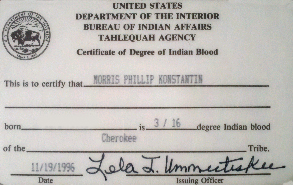Certificate of Degree of Indian Blood facts for kids
A Certificate of Degree of Indian Blood (CDIB) is an official document from the United States government. It proves that a person has a certain amount of Native American ancestry. This ancestry must be from a federally recognized tribe, band, or community. The CDIB is issued by the Bureau of Indian Affairs.
What is a CDIB?
The CDIB shows how much Native American ancestry a person has. This is often called "blood degree." For example, it might say someone is 1/4 or 1/16 Native American. This degree is based on their birth parents' ancestry. It cannot be obtained through adoptive parents.
How Do You Get a CDIB?
To get a CDIB, you need to show your family history. This is called a genealogy. You must provide official documents like birth certificates. These documents prove your connection to a Native American person listed on official tribal rolls. An example of such a roll is the Dawes Rolls. The "blood degree" is figured out using these past records. All your personal information collected for the CDIB is kept private.
What is the CDIB Used For?
A CDIB can show your ancestry from one specific tribe. Or, it can show your total Native American ancestry from all tribes.
Some tribes require a certain amount of tribal ancestry for membership. For example, the Eastern Band of Cherokee Indians needs at least 1/16 Eastern Cherokee blood for someone to join their tribe.
The CDIB is also used for some federal programs. For instance, the Bureau of Indian Affairs' Higher Education Grant helps with college costs. To qualify, you might need a minimum of 1/4 total Native American blood.
It's important to know that a CDIB does not automatically make you a member of a tribe. Each tribe has its own rules for membership. These rules might or might not require a CDIB.
Why is the CDIB Debated?
The CDIB can be a topic of discussion. One reason is that only members of federally recognized tribes can get one. This means that people from tribes not recognized by the U.S. government cannot get a CDIB. They also cannot get benefits that require one.
Sometimes, groups like the Cherokee Freedmen were not eligible for a CDIB. This was because their Native American ancestry was not recorded in the same way on the official rolls. Instead, the rolls might have listed them as "Freedmen" without a specific blood degree.


